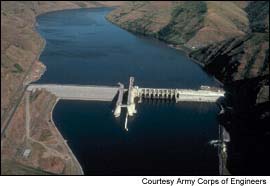forum
library
tutorial
contact

Snake River Dams Defy Clean Water Act
by Margot HigginsEnvironmental News Network, May 2, 2000
|
the film forum library tutorial contact |

|
Snake River Dams Defy Clean Water Actby Margot HigginsEnvironmental News Network, May 2, 2000 |
 Four controversial dams on the lower
Snake River may have another federal
act to follow.
Four controversial dams on the lower
Snake River may have another federal
act to follow.
Besides complying with the Endangered Species Act, the dams must also meet the terms of the Clean Water Act if they are to remain in place.
The U.S. Environmental Protection Agency last week informed the U.S. Army Corps of Engineers that removing four dams along the lower Snake River is probably the only option that will satisfy the Clean Water Act.
The EPA's position comes in the wake of a recent National Marine Fisheries Service announcement that it will likely postpone dam removal for five to 10 years. Conservationists argue that every moment counts for Snake River salmon and steelhead, whose extinctions are predicted to occur as early as 2017.
"The EPA is confirming what we've been saying all along — that the four lower Snake River dams don't make sense for clean water and that removing them is the best option for protecting clean water and salmon," said Mark Van Putten, president of the National Wildlife Federation. "Scientists tell us that removing these four dams is vital for healthy salmon runs. Fishermen and communities will see widespread economic benefits from dam removal. And now we have another common sense, science-based reason to remove these dams: clean water."
On March 24, a federal judge ruled that the Corps' operation of the lower Snake River dams must comply with Clean Water Act standards. The decision, which followed a lawsuit filed by conservation groups and the Nez Perce tribe, did not say whether the dams violate the act.
The EPA, one of nine federal agencies involved in the dam-removal decision, has concluded that the dams cause water-quality violations that degrade the health of the watershed, killing and injuring salmon. So far, the U.S. Fish and Wildlife Service is the only other agency to conclude that dam removal is the best alternative for salmon recovery.
The EPA delivered its comments in response to the Corps' $20 million Draft Environmental Impact Statement on the lower Snake River dams that was released in December 1999. The study outlined several alternatives to dam breaching. The Corps claimed the dams do not adversely effect water quality, but the EPA findings contradict the agency's conclusion.
 Three Corps alternatives to removing
the dams were deemed
"environmentally unsatisfactory" by the
EPA.
Three Corps alternatives to removing
the dams were deemed
"environmentally unsatisfactory" by the
EPA.
"The draft environmental impact study does not adequately characterize the impact of the existing dams on water quality," the EPA noted. "We are particularly concerned with the ... treatment of temperature. The (study) concludes that the lower Snake River dams actually lower water temperatures. We believe that this conclusion results from selective use of data and selective use of modeling results."
EPA studies have demonstrated that the dams raise water temperatures by fluctuations that occur under free-flowing river conditions. High water temperatures threaten the survival of young salmon by decreasing their energy levels, diminishing their food supply and making them more susceptible to predators and disease.
Short of dam removal, eliminating the water pollution caused by the dams could cost taxpayers $460 million to $900 million. Conservationists warn that even that amount of money may not solve the problem of water quality in the river.
If the Corps and the EPA do not reach an agreement on the findings, the issue will have to be settled at the executive level by the Council on Environmental Quality.
"I think the Clean Water Act will be a major part of the decision making process on whether or not to remove the dams," said Bill Dunbar, press secretary for the EPA
learn more on topics covered in the film
see the video
read the script
learn the songs
discussion forum
